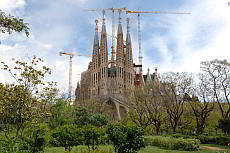Sant Jordi - Day of the Book and the Rose
Sant Jordi is also the day of the patron saint of Catalonia
23rd April: On the day of Sant Jordi in Barcelona - as in all of Catalonia - people give one another a rose or a book. Not only couples do this. The Generalitat in Plaça de Sant Jaume is open to the public. In the palace and around it there is a large rose market. You can buy books everywhere.
Sant Jordi: Day of the Book and the Rose
Documents show that the tradition of giving away roses as a symbol of love on the day of Sant Jordi, dates back to the 15th century, even though the exact date is not known. Furthermore, why this day is the day of lovers and Sant Jordi has become the patron saint of lovers is not known with certainty. In the most famous legend of Saint George he didn’t marry the princess - although he released her from the dragon - as the moral of this story was Christian baptism rather than love, according to the legend (see below).
In 1926 Spain declared the 23rd April, the anniversary of the death of Miguel de Cervantes, the most famous Spanish writer, as Book Day. This was coping England, who had also respected the 23rd April as the death of Shakespeare. It was a coincidence that this coincided with the day of the feast of Sant Jordi. This led, however, to mean that Book Day was hardly celebrated. Only much later did the day of love also became a day of literature in the mind of the population.
The 23rd April, the day of Sant Jordi, the patron saint of Catalonia, is today the day of the rose and the book, the day of love and culture.
World Book and Copyright Day
In 1995 UNESCO declared 23rd April as World Book and Copyright Day. This was to acknowledge that the book has historically contributed most to the spread of knowledge. The proliferation of books is a cultural enrichment throughout the world.
The history and legend of Saint George (Sant Jordi)
Sant Jordi in Barcelona
As with many traditions that are firmly rooted in society, today we know very little about their origin. To understand the traditions on the day of Sant Jordi, one must immerse oneself in some of the stories and legends that have sprung up around Saint George.
Although George was venerated in the Middle Ages in Europe, today we know very little about this historical figure. It is certain that he served as a Roman soldier around 300 AD. He was regarded as a Christian martyr who would not be questioned about his beliefs. The name "Georgius" means farm, which is perhaps the reason why the Catholic liturgy chose this day in spring as his name day. He is also regarded as a protector of the harvest.
In addition, he is also regarded as protector of lovers, which explains why since the 15th Century a large rose market takes place around the government palace (Generalitat de Catalunya) in Plaça Sant Jaume and in its courtyard on the day of Sant Jordi.
Because so little is known of the historical figure, the myths and legends around the Catalan patron grow. A legend tells of his seven-year Mathyrium. In the seven years of torture Sant Jordi never lost his faith. This legend explains why Jordi was chosen as patron saint of the Knights of the Byzantine Empire. During this time he was called out for help to win against the "infidels". In addition to Catalonia he was also chosen as the patron saint of England, Georgia, Greece and Serbia and many more.
The best known and most popular legend describes how he defeated a dragon in the infinite country Silene. This dragon poisoned the air of a village. And to appease him, the people always sacrificed a lamb and a virgin who was chosen. One day the princess of the country met this fate; George killed the dragon and freed her. The Princess and the entire population were converted to Christianity. Since the 13th century the most widely used figure of Sant Jordi is the scene where he kills the dragon with a lance while riding a white horse.
The worship of Sant Jordi in Catalonia
Since the 8th century Sant Jordi is venerated in Catalonia. Evidence for this is that many churches and chapels have been dedicated to his memory. Even the kings adored him; Jaume I even describes how the Catalan Sant Jordi helped in the conquest of Mallorca. Under the protection of Sant Jordi an Order of Knights was founded. Since 1343 Sant Jordi has been celebrated in the Catalan land of Valencia, and in Majorca since 1407. In 1456 the Catalan Parliament adopted a constitution in the cathedral of Barcelona declaring Sant Jordi as a festival day.
The fact that the worship of Sant Jordi takes place in all areas is also shown at the government palace of Catalonia at Plaça Sant Jaume. Here in the 19th Century a medallion of Sant Jordi was installed on the gothic facade and inside the building a chapel was built in honor of him.
At many attractions in Barcelona today you can see the cult of Sant Jordi. One example is the so called Casa Batlló, built by Gaudí, whose roof resembles a dragon.
Book your accommodation in Barcelona here! All categories.
1-5*-hotel rooms, apartments, hostels.










